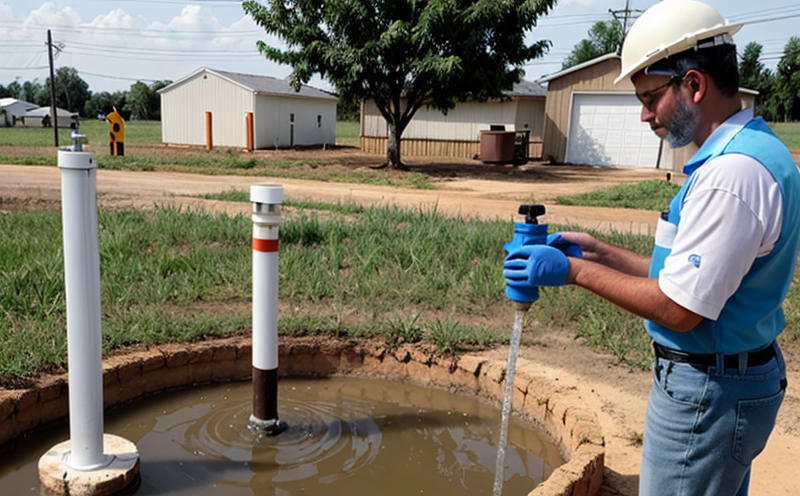EPA Method 245.1 Mercury in Groundwater
The EPA Method 245.1 is a standardized analytical procedure designed to measure the concentration of mercury in groundwater samples. This method is essential for regulatory compliance and environmental monitoring, particularly where stringent limits on mercury contamination are required.
Mercury, a toxic heavy metal, can have significant adverse effects on human health and aquatic ecosystems if present at high levels. Groundwater serves as a vital resource for drinking water supplies and agricultural activities, making accurate measurement of mercury critical to maintaining public safety and environmental integrity.
The method involves several stages: sample collection, preservation, digestion, and analysis using cold vapor atomic absorption spectrophotometry (CV-AAS). This technique ensures precise quantification by converting elemental mercury into a form that can be easily measured. The CV-AAS system is chosen for its high sensitivity, selectivity, and low detection limits.
The procedure outlined in EPA Method 245.1 is rigorously standardized to ensure consistency across different laboratories and regions. This standardization is crucial for accurate comparison of results and effective enforcement of environmental regulations.
In summary, the method provides a robust framework for detecting mercury contamination in groundwater, enabling stakeholders to take timely and appropriate actions towards protecting public health and the environment.
- Sample Collection: Proper collection ensures the integrity of the sample. This includes avoiding cross-contamination and maintaining chain-of-custody documentation.
- Preservation: Samples are preserved to prevent degradation before analysis, often through acidification or refrigeration.
- Digestion: The digestion step breaks down complex organic compounds to release mercury for measurement.
- Analytical Technique: CV-AAS is used due to its high sensitivity and selectivity for mercury detection.
The method's accuracy, precision, and compliance with international standards (ISO, ASTM) make it a cornerstone in environmental monitoring efforts. By adhering to EPA Method 245.1, laboratories can ensure that results are reliable and meet stringent regulatory requirements.
Quality and Reliability Assurance
The quality of analytical results is paramount in environmental testing, especially when addressing the presence of contaminants like mercury. At our laboratory, we employ a comprehensive Quality Management System (QMS) to ensure the reliability and accuracy of EPA Method 245.1.
Our QMS includes strict adherence to methodological protocols, regular calibration of instruments, proficiency testing, and internal audits. By implementing these practices, we minimize errors and ensure that each test conducted meets the highest standards of quality.
We also participate in inter-laboratory comparisons with other accredited laboratories to validate our results against industry benchmarks. This continuous improvement process helps us stay current with any changes or updates to EPA Method 245.1.
Our commitment to quality is further underscored by our participation in proficiency testing programs, such as those conducted under the National Environmental Laboratory Accreditation Conference (NELAC) and ISO/IEC 17025 standards. These initiatives ensure that our methodologies remain robust and compliant with international best practices.
Customer Impact and Satisfaction
The impact of accurate mercury testing through EPA Method 245.1 extends beyond mere compliance; it directly influences the health and well-being of communities relying on groundwater resources.
- Public Health: Reliable detection of mercury contamination allows for timely interventions to protect drinking water supplies from potentially harmful levels.
- Agricultural Safety: Ensuring that agricultural runoff does not introduce toxic levels of mercury into groundwater helps safeguard food safety and livestock health.
- Ecosystem Protection: By identifying areas at risk due to elevated mercury concentrations, we assist in the development of strategies to mitigate environmental damage.
Our customers benefit from the peace of mind that comes with knowing their water supplies are being rigorously tested and monitored for compliance. This service not only supports regulatory adherence but also fosters trust between stakeholders and the communities they serve.
Competitive Advantage and Market Impact
The adoption of EPA Method 245.1 provides a competitive edge in several key areas:
- Regulatory Compliance: By consistently meeting or exceeding regulatory standards, our customers can avoid costly fines and legal issues.
- Risk Management: Early detection of mercury contamination allows for proactive mitigation strategies, reducing potential risks to both operations and the environment.
- Credibility and Reputation: Demonstrating a commitment to high-quality testing enhances the reputation of our customers in their respective markets.
- Innovation: Our expertise with EPA Method 245.1 enables us to contribute to cutting-edge research projects focused on environmental sustainability.
The ability to deliver accurate and reliable test results through this method positions our clients as leaders in environmental stewardship, which is increasingly valued by consumers and regulators alike.





